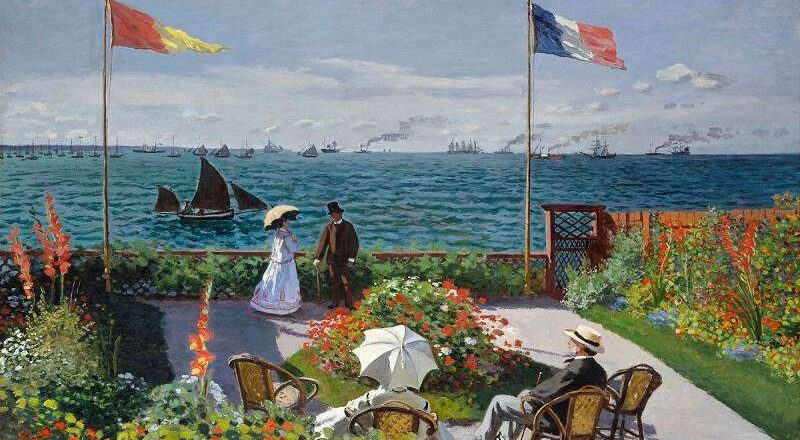Latest designs on EuropeZigZag.shop
Let’s explore the serene and invigorating atmosphere found within the three illustrious Impressionist museums in Paris: the Musée d'Orsay, the Musée de l'Orangerie, and the Musée Marmottan Monet. Each of these spaces not only houses remarkable works of art but also embodies the essence of Impressionism, inviting visitors to lose themselves in its vibrant world.
Musée d'Orsay
When you walk into the Musée d'Orsay, you can’t help but feel amazed by the beautiful old Beaux-Arts railway station that’s been turned into a museum. With its tall ceilings and spacious galleries, it’s the perfect spot to explore some truly incredible art. You’ll find an impressive collection of Impressionist works here, featuring well-known artists like Claude Monet, Pierre-Auguste Renoir, and Édouard Manet.
Paintings to admire
Claude Monet’s “Water Lilies” series invites us into the tranquil beauty of his garden pond in Giverny, where light dances on the water’s surface and reflects the vibrant flora surrounding it. This enchanting experience is paralleled in Camille Pissarro’s captivating landscapes, like “The Boulevard Montmartre, Spring,” which masterfully reveal the energy of urban life seamlessly intertwined with the beauty of nature.
As we stroll through the world captured by Gustave Caillebotte in “Paris Street, Rainy Day,” we find ourselves amidst a lively urban scene, where figures navigate the streets under their umbrellas, painting a vivid picture of contemporary Parisian life. Meanwhile, Pierre-Auguste Renoir’s “Dance at Bougival” bursts with vitality, showcasing an outdoor gathering alive with sunlight and movement, demonstrating the magical interplay of light with the joyful scenes of life around it.
While traditional art often conformed to rigid rules and idealized forms, Impressionism emerged in the late 19th century as a revolutionary movement of artists who sought to capture the fleeting effects of light and color. In Monet’s “Water Lilies,” the luminous reflections create an almost tangible experience, where the scene feels alive, inviting us to pause and appreciate the present. As you immerse yourself in this vibrant atmosphere, take a moment to reflect on how to see the beauty in everyday life and to savor the fleeting moments that connect us to the here and now.

Musée de l'Orangerie
Just a quick walk away is the Musée de l'Orangerie, a lovely spot tucked away in the Tuileries Garden. This museum is well-known for its cozy vibe and the stunning “Nymphéas” (Water Lilies) paintings by Monet that fill the oval rooms. The gentle curves of the walls and the soft light coming through the windows create a peaceful atmosphere that’s just right for some quiet time.
Here, you can really see how Impressionism evolved. Monet's later works take a turn towards abstraction, showing off his deep understanding of color and form. They invite you to see nature in a new, almost meditative way. The vibrant greens, rich blues, and soft pinks of the water lilies bring a sense of calm, encouraging visitors to appreciate the beauty of the natural world. It’s a great place to reflect on how Impressionism didn’t just capture reality; it turned it into something deeply emotional.
Paintings to admire
Step into the serene world of Monet's extraordinary “Nymphéas” (Water Lilies) paintings, elegantly housed in two oval rooms that invite you to lose yourself in the enchanting ambiance of his beloved water garden. Here, every brushstroke dances with color and light, capturing the ever-changing essence of nature as it shifts throughout the day. As you wander through this immersive experience, you’ll feel the fleeting moments of beauty that remind us how precious and transient our perceptions can be. Let the tranquility of Monet’s vision inspire you to embrace the beauty surrounding us in each passing moment.
Musée Marmottan Monet
You’ve gotta check out the Musée Marmottan Monet! It’s a bit of a hidden gem nestled in a lovely little mansion. This place has the biggest collection of Monet’s artwork, including the famous “Impression, Sunrise” that kicked off the whole Impressionist movement. The cozy galleries are decorated with charming chandeliers and warm colors, making it a really inviting spot to relax and soak in some art.
Paintings to admire
Monet’s “The Artist's Garden at Giverny” bursts forth with the brilliant colors of nature, inviting us to marvel at the beauty that surrounds us. His fascination with vibrant hues and forms draws us into a world where each brushstroke breathes life into a garden in full bloom. Similarly, works by Morisot, such as “The Cradle,” capture the intimate moments of family life, revealing the quiet yet profound beauty of maternal love.
As we explore these pieces, we can feel the evolution of Impressionist themes reflected in the dynamic brushstrokes and carefully crafted compositions. Strolling through the galleries, we experience the lively pulse of Parisian life as seen through the eyes of artists like Gustave Caillebotte, juxtaposed with the peaceful serenity of Monet’s garden scenes. This contrast fosters a deep connection to the art, encouraging us to contemplate the passage of time and the ever-evolving world, all through the transformative lens of Impressionism.
Leaving these museums, we don’t just take with us echoes of the past; we carry a renewed sense of wonder and appreciation for the world we inhabit. It’s a reminder of the very spirit that fueled the Impressionist movement, inspiring us to see beauty in the everyday and encouraging us to embrace the artistry of life itself.







